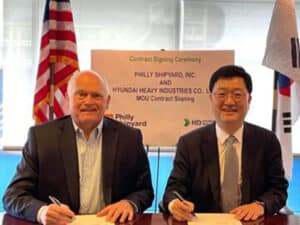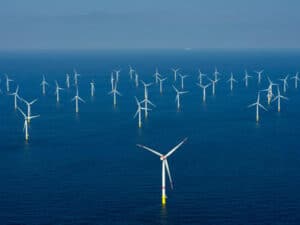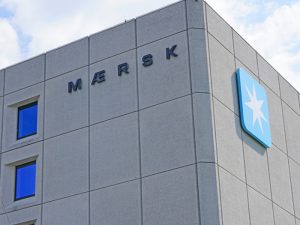
U.S. moves ahead on LNG as marine fuel
Written by Nick Blenkey
FMC Commissioner William P. Doyle
MAY 16, 2014 — Though, as yet, there’s not one LNG fueled vessel actually operational in the U.S., the adoption of LNG as fuel by U.S. operators is proceeding at a pace that has taken many observers by surprise.
Federal Maritime Commissioner William P. Doyle gave an excellent summary of what’s been happening at this month’s LNG as a Marine Fuel Conference in Calgary, Canada.
Following is taken from the text of his prepared remarks:
Liquefied Natural Gas (LNG) as a marine fuel is taking hold in the United States. The Obama Administration strongly supports LNG as a marine fuel and is investing in the utilization of the fuel on ocean going ships. The Obama Administration is also embracing LNG’s potential on vessels working on the inland waterways. There is an abundant supply of natural gas in America. Natural gas has some positive environmental benefits when compared to traditional marine fuels. Considering the economics, natural gas is a more cost effective fuel source than marine residual and distillate fuels. The maritime industry is in the process of developing, converting and constructing LNG powered vessels. Bunkering for LNG vessels is an important component that is being explored and examined.
U.S. Supporting LNG as a Marine Fuel
Yesterday, Totem Ocean Trailer Express (TOTE) President & CEO Anthony Chiarello was honored at the White House as a 2014 transportation industry “Champion of Change.” He was chosen for his role in leading the U.S. maritime industry toward natural gas as fuel.
Under the Obama Administration, the United States Department of Transportation’s Maritime Administration is sponsoring a $1.4 million program for two projects supporting the increased use of alternative fuels and technology in the maritime industry.
The first project is a public-private partnership between the Maritime Administration and U.S.-flag carrier Horizon Lines for the conversion and monitoring of one of its vessels to operate on LNG fuel. The second project includes a study being conducted by the U.S. subsidiary of Det Norske Veritas Inc. (DNV) to analyze the issues and challenges associated with bunkering of LNG powered vessels.
With respect to the inland waterways, there is an ongoing Pittsburgh Marine Corridor Natural Gas Feasibility Assessment which is examining whether realistic opportunities exist for converting inland waterways vessels from diesel to natural gas propulsion. This Assessment is being conducted through collaboration between Life Cycle Engineering, 3 Rivers Clean Energy, Marshall University Rahall Transportation Institute, and the Shearer Group, LLC.
Next, the Port of Pittsburgh is funding the assessment and requirements of potential fueling sites as well as a cost benefit analysis for the conversion of vessels to LNG. According to U.S. Army Corps of Engineers, Pittsburgh is the third busiest inland port in the United States. About 34 million tons of cargo move through the Port of Pittsburg each year. Approximately 45,000 jobs are dependent upon this inland waterway transportation system.
The U.S. Department of Energy and the U.S. Maritime Administration are involved in these projects along with the Pittsburgh Region Clean Cities non-profit organization, the Richard King Mellon Foundation, the Benedum Foundation, and other industry companies.
The Pittsburgh Region Clean Cities is the designated regional organization for all U.S. Department of Energy Clean Cities initiatives. Clean Fuels/Clean Rivers is an initiative to build a natural gas marine corridor that includes the Pittsburgh river systems.
Importantly, the private sector has expressed strong interest and there are ongoing discussions regarding a demonstration project to convert an existing towboat to LNG power.
Environmental Benefits of Natural Gas
The use of LNG reduces sulfur oxide (SOx) emissions by between 90% and 99%. SOx is the major contributor to acid deposition otherwise known as acid rain. This reduction in emissions brings SOx emissions within limits mandated by the Emission Control Areas designated by the IMO. Using LNG reduces nitrous oxide (NOx) emissions by approximately 90%. NOx is a major contributor to smog. Finally, LNG has a lower carbon content than traditional bunker fuels, giving off up to 25% less CO2 emissions.
Under MARPOL’s Annex VI, progressively more limits for NOx and SOx emissions are being placed on the global shipping industry over the next decade. Within U.S. waters, these requirements are implemented through the Act to Prevent Pollution from Ships (APPS). NOx emission limits are being imposed in a tiered approach, based on engine speed, while SOx is being limited primarily by regulating sulfur content in fuel.
Economic Benefits of LNG as a Marine Fuel
Based on the current forecasts, natural gas delivered for production of LNG in the U.S. is now more than 50% less expensive on an energy equivalent basis than marine residual fuel and marine distillate fuel. It is projected that this relative price advantage will continue, and even increase, through 2035. This has opened up an opportunity for significant annual fuel cost savings when converting marine vessels that use petroleum fuel to natural gas operation.
About 70% of domestic shipping relies on distillate fuel oil and the remaining 30% relies on residual fuel oil. By contrast, over 90% of international shipping is fueled by residual fuel oil. In comparison to distillate fuel, residual fuel is much more viscous – and is essentially a solid at room temperature. Residual fuel must be heated to keep it in liquid form for transport and storage as a marine fuel. Residual fuel also has significantly higher sulfur content than distillate fuel – 1% sulfur or more – and much higher heavy metal content. Residual fuel is less expensive than distillate fuel.
Examples of Projects in the United States Moving Forward on LNG as a Marine Fuel
In February, General Dynamics NASSCO shipyard in San Diego, California held a ceremony marking the first cut of steel for the construction of TOTE’s new Marlin Class container ship. It is expected to be the first LNG-powered containership in the world. TOTE expects to build two of these LNG powered vessels and homeport them in Jacksonville, Florida and operate them in the U.S. mainland to Puerto Rico trade. The new Marlin Class vessels will create a reduction of sulfur dioxide (SOx) emissions by 98 percent, particulate matter (PM) by 99 percent, nitrous oxide (NOx) and carbon dioxide (CO2) by 71 percent over TOTE’s ships currently operating in Puerto Rico.
TOTE intends to strategically locate LNG fueling stations that will be an integral part of its operations. To this end, in February, TOTE announced an agreement with Pivotal LNG and WesPac Midstream to provide LNG to the ships by developing a new LNG fueling facility in Jacksonville, Fla.
TOTE is also currently in the process of converting its two 839-foot, MAN-powered Orca-class Ro/Ro vessels to mostly LNG operation. These vessels operate in the Tacoma, Washington to Anchorage, Alaska trade. In 2012, the U.S. Coast Guard granted TOTE the waiver it needs to convert the vessels while they remain in service. TOTE said that its conversion program is the product of a public-private partnership among TOTE, the U.S. Environmental Protection Agency, and the U.S. Coast Guard. TOTE has selected Wärtsilä to supply the main engines, generators and integrated LNG storage and fuel gas handling systems for the conversion project.
In November 2013, Crowley announced it had executed agreements with shipbuilder VT Halter Marine Inc., of Pascagoula, Miss., to build two of the world’s first LNG-powered combination container – Roll-On/Roll-Off (ConRo) ships. The ships will operate in the United States mainland to Puerto Rico trade. The vessel design is the work product of Wärtsilä Ship Design in conjunction with Crowley subsidiary Jensen Maritime, a Seattle-based naval architecture and marine engineering firm.
Additionally, in September 2013, Aker Philadelphia Shipyard and Crowley announced a partnership to build up to eight (8) tankers. Citing the monumental shale related activity in the United States, the parties are securing their respective positions due to the increased demand for U.S.-built tankers. These tankers are designed to allow the ships to convert to LNG power.
In November 2013, Aker Philadelphia Shipyard announced it had been selected by Matson Navigation Company (Matson) to construct two 3,600 TEU containerships. The containerships will be utilized in Matson’s service from the U.S. West Coast to Hawaii. The vessels will be built with dual fuel engines and will be ready for conversion to LNG propulsion.
General Dynamics NASSCO shipyard currently has contracts and options to construct seven (7) LNG conversion ready U.S.-Flag tankers. NASSCO has agreements with Seabulk Tankers and American Petroleum Tankers (now Kinder Morgan Tankers).
At the beginning of 2014, Zeus Development Corporation identified approximately 42 vessels in North America that are under development or evaluation for conversion to LNG fuel.
LNG Bunkering in North America: LNG powered ships will need to refuel.
In February, the U.S. Coast Guard issued a notice seeking public comment on two draft policy letters regarding safety measures for LNG as a marine fuel. The first draft policy letter provides voluntary guidance for LNG fuel transfer operations on vessels using natural gas as a fuel and for the training of personnel. The second draft policy letter discusses voluntary guidance and existing regulations applicable to vessels and land based facilities conducting LNG marine fuel bunkering operations, and provides voluntary guidance on safety, security, and risk assessment measures for these operations.
In March, the American Bureau of Shipping (ABS) released a report entitled Bunkering of Liquefied Natural Gas-Fueled Marine Vessels in North America. The objective of the report is to provide guidance to potential owners and operators of gas-fueled vessels, as well as LNG bunkering vessels and facilities, to help them obtain regulatory approval for projects.
Last month, the West Coast Marine LNG Joint Industry Project Steering Committee in Canada issued a report stating that Vancouver is positioned to be North America’s preferred LNG bunkering destination.
In February, Harvey Gulf International Marine broke ground for its $25 million LNG fueling facility at Port Fourchon, La. In January, Gulf Coast Shipyard Group (GCSG) launched the first of six Harvey Gulf International Marine Dual Fuel (LNG) Offshore Supply Vessels.
Last year, Texas-based Waller Marine announced it would build a small-scale LNG facility at the Port of Greater Baton Rouge, Louisiana, to fuel vessels.
I hope that I have presented you with some meaningful insight on LNG marine fuel projects and developments. This sector is new but growing– and there appears to be many opportunities available for those looking to operate LNG fueled vessels and/or enter into the LNG bunkering and fueling sectors.





Leave a Reply
You must be logged in to post a comment.